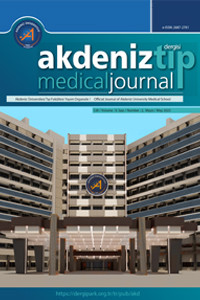Alt Ekstremite Geniş Defektlerinin Peforatör Flepler İle Onarımı: Serbest Flep İle Rekonstrüksiyona Alternatif Çözüm
Abstract
Amaç: Alt ekstremite doğumsal veya edinsel doku defektlerinin uygun şekil ve fonksiyonel onarımı, plastik cerrahinin temel konularındandır. Bu makalede rekonstrüksiyonu zor olan bu anatomik bölgenin farklı tedavi yöntemlerini ve serbest flep ile rekonstrüksiyona alternatif çözüm metotlarını araştırdık, ayrıca defektin lokalizasyonuna ve büyüklüğüne bağlı olarak tedavi algoritmasını gözden geçirdik.
Gereç ve Yöntemler: Bu çalışmada; 2011–2017 tarihleri arasında, alt ekstremite yumuşak doku defekti tanısıyla cerrahi olarak tedavi edilen 27 olgu, defektin yerleşim yerine göre tercih edilen tedavi alternatifleri ve perforator fleplerin serbest fleplere olan avantajları yönünden değerlendirildi. 7 hastada proksimal 1/3 kruris yerleşimli yumuşak doku defekti, 12 hastada orta 1/3 kruris yerleşimli yumuşak defekti, 8 hastada ise distal 1/3 kruris yerleşimli alt ekstremite yumuşak doku defekti mevcuttu.
Bulgular: 3 olguda erken venöz konjesyon, 1 olguda yara yeri enfeksiyonu izlendi. Venöz konjesyon kendiliğinden geriledi, yara yeri enfeksiyonu uygun yara bakımı ile iyileşti. 3 olguda flep distalinde parsiyel flep kaybı izlendi, ikinci bir operasyona gerek kalmadan yara bakımı ile tedavi edildi.
Sonuç: Perforatör flepler, alt ekstremite yumuşak doku defekti rekonstruksiyonunda güvenilir ve etkili bir yöntem olup travma sonrası erken dönemde başarıyla uygulanabilir. Cerrahi tekniğin nispeten kolay olması ve mikrocerrahi gerektirmemesi nedeniyle güvenle uygulanabileceğini düşünmekteyiz.
References
- 1. Thorhe CH. Techniques and principles in plastic surgery. In: Aston SJ, Beasley RW, Bartlett SP, Thorhe CH. (Eds.). Grabb and Smith’s Plastic Surgery. 6th Edition. Lippincott-Raven Publishers, Philadelphia, 2007.
- 2. Santoni -Rugiu P, Sykes PJ. A history of plastic surgery 2007.
- 3. Less. Plastic & Reconstructive Surgery. 58(3):283-291, Luce, Edward A.; McClinton, Michael; Hoopes, John E. Less. September 1976.
- 4. Koshima I, Yamamoto T, Narushima M, Mihara M, Lida T. Perforator flaps and supermicrosurgery. Clin Plastic Surg. 2010; 37: 683–689.
- 5. Vedder NB. Flap physiology. In: Mathes SJ (Eds.), Plastic Surgery. 2th Edidion. Saunders Elsevier. Philadelphia, 2006; 483-506.
Reconstruction Of Lower Limb Wide Defects With Perforator Flaps: Alternative Solution To Reconstruction With Free Flap
Abstract
Objective: Repair of lower limb congenital or acquired tissue defesct in proper shape and function is the main topic of plastic surgery. In this article, we investigated different treatment methods of this anatomical region which is difficult to reconstruction and alternative solution methods to reconstruction with free flap, and also reviewed the treatment algorithm depending on the localization and size of the defect.
Material and Methods: In this study; between 2011 and 2017, 27 patients who were surgically treated with a soft tissue defect in the lower extremity were evaluated according to treatment alternative for defect location and advantages of perforator flap to free flap. There were lower extremity soft tissue defect located in the proximal 1/3 cruris in 7 patients, in the middle 1/3 cruris in 12 patients and in the distal 1/3 cruris in 8 patients.
Result: Early venous congestion was observed in 3 cases and wound infection was observed in 1 case. Venous congestion resolved spontaneously, wound infection healed with appropriate wound care. In 3 cases, partial flap loss was observed distal to the flap, and was treated with wound care without the need for a second operation.
Conclusion: Perforator flaps are a reliable and effective method for repairing soft tissue defects of the lower limbs and it can be applied successfully in the early period after trauma. We think that it can be applied safely cause of the surgical technique is relatively easy and does not require microsurgery.
References
- 1. Thorhe CH. Techniques and principles in plastic surgery. In: Aston SJ, Beasley RW, Bartlett SP, Thorhe CH. (Eds.). Grabb and Smith’s Plastic Surgery. 6th Edition. Lippincott-Raven Publishers, Philadelphia, 2007.
- 2. Santoni -Rugiu P, Sykes PJ. A history of plastic surgery 2007.
- 3. Less. Plastic & Reconstructive Surgery. 58(3):283-291, Luce, Edward A.; McClinton, Michael; Hoopes, John E. Less. September 1976.
- 4. Koshima I, Yamamoto T, Narushima M, Mihara M, Lida T. Perforator flaps and supermicrosurgery. Clin Plastic Surg. 2010; 37: 683–689.
- 5. Vedder NB. Flap physiology. In: Mathes SJ (Eds.), Plastic Surgery. 2th Edidion. Saunders Elsevier. Philadelphia, 2006; 483-506.
Details
| Primary Language | Turkish |
|---|---|
| Subjects | Clinical Sciences |
| Journal Section | Research Article |
| Authors | |
| Early Pub Date | April 28, 2023 |
| Publication Date | May 1, 2023 |
| Submission Date | October 22, 2021 |
| Published in Issue | Year 2023 Volume: 9 Issue: 2 |

